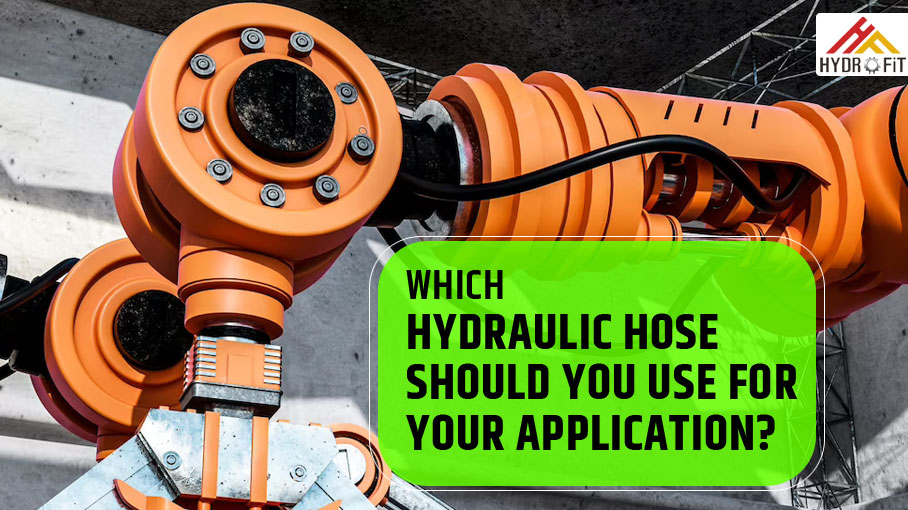Which hydraulic hose should you use for your application?
Posted on August 8th, 2023
Hydraulic hoses are essential in practically all hydraulic systems, so picture the inconvenience if one suddenly fails. Furthermore, the hose’s flexibility allows the system’s components to be put in the most convenient or efficient areas because it can get around corners, into tight spaces, and across various lengths.
However, due to the enormous variety of options available today, choosing the proper hose can be extremely difficult. What distinguishes one type from another? Is there a more straightforward way to select the correct type?
As a result, the professionals have created a guide containing everything you need to know to pick the best hydraulic hose for your needs. What exactly are you waiting for?
What Exactly Is Hydraulic Hose?
A hydraulic hose is a speciality in various commercial and industrial contexts. Hydraulic hoses are usually made of flexible rubber or wire, with a sequence of layers to provide strength and longevity. An inner tube, a reinforced layer, and an exterior layer comprise these layers.
What Is the Function of a Hydraulic Hose?
A hydraulic hose, like a hose you could use to water your lawn, allows fluid to flow from one component to another – in this instance, hydraulic fluid. The hose is the conduit that guarantees the fluid travels freely, and it is an essential aspect of keeping hydraulic fittings running. If a hydraulic hose fails, it can halt whole manufacturing lines and shut down critical gear until the hose can be replaced.
Who Is the User of Hydraulic Hoses?
Hydraulic hoses are utilised in a wide range of industries. Hydraulic hoses can be found in manufacturing assembly lines, fleet cars and plants, and commercial farming.
What Kinds of Hydraulic Hoses Exist?
This type of hydraulic hose is lighter than its metal counterparts, making it easier to transport the hydraulic fittings. It can also be strengthened by adding a fibreglass or steel mesh that prevents bending, bulging, and scratching. It can also endure high temperatures and connect many hose fittings.
-
Hose Braided:
This high-pressure hose has one, two, or three braided steel wires used to power general industrial applications. It typically works with petroleum or water-based fluids and can operate from -40°C to 100°C.
-
Hose With Many Spirals:
This hose is highly flexible, and its internal structure makes it especially useful in heavy-duty and high-pulse applications. It is typically used to transport mineral and hydraulic oils or water-oil emulsions, making it particularly helpful in construction and civil engineering, mining and quarrying, oil industries, and agriculture, among other applications.
-
Low-Pressure Hose:
This textile-braided hose makes it exceedingly flexible but incompatible with more significant pressures. It’s most typically used in lightweight applications like anti-static supply, air, lubrication, and return lines.
-
Stainless Steel Wire-Braided Hose:
The hoses are braided with single or double stainless-steel wire. They’re used in tough environments like chemical transportation. They are adamant and can survive severe temperatures and pressures, including in a vacuum.
-
Hydraulic Hose Made of Thermoplastic:
They are comprised of two layers of thermoplastic material separated by a central reinforcing layer consisting of wire or synthetic fibres. They are common in hydraulic-powered lift equipment and lubrication lines when a small outer diameter is required because they can operate at very low temperatures and are particularly resistant to abrasion.
How Do I Select the Best Hydraulic Hose?
All hydraulic hoses are not the same. When looking for a new or replacement hydraulic hose, you must contact a specialist who can locate or create the best stocking for your requirements.
When designing a hydraulic system, there are seven elements to consider when choosing the correct hose and couplings. So, remember the abbreviation STAMPED to make your life easier when determining the suitable tube for a new application. Size, Temperature, Application, Materials, Pressure, Ends, and Delivery are acronyms.
Summary
Unless you work in an industry that requires hydraulic-powered technology, you’re unlikely to know what a hydraulic hose does (or even that such a thing exists). The truth is that hydraulic hoses are an essential component in allowing many Indian enterprises to operate. Therefore, they’re a fundamental cog on which millions rely daily.
Contact Hydrofit Trading & Engineering or look through our online catalogue. With thousands of hydraulic components in store and a 24-hour emergency call-out service for hydraulic hose crises, we are India’s largest network of professionals. Our expertise and experience will assist you in making the most of your hydraulic equipment and extend your parts’ life.

